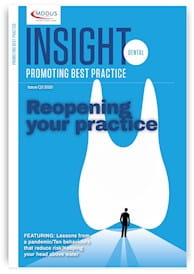 DENTAL teams are facing unprecedented levels of challenge, change and uncertainty. Over the next few months it’s likely that you and your team will experience negative feelings such as elevated anxiety due to the complications of delivering continuing dental care amidst a pandemic.
DENTAL teams are facing unprecedented levels of challenge, change and uncertainty. Over the next few months it’s likely that you and your team will experience negative feelings such as elevated anxiety due to the complications of delivering continuing dental care amidst a pandemic.
If you have a formal leadership role, you will be working – visibly or in the background – to understand and assess the nature of risk, make decisions and take action so that appropriate conditions are created within which safety is supported. Setting up safe systems, adapting policies and procedures (including to raise concerns and report/respond to incidents), ensuring safety of equipment and other environmental factors are massively important.
However, without careful consideration of the human aspect of your team, including their wellbeing and the emotional impact of current working conditions, the value of these important risk management activities can be undermined.
Practising and encouraging the following behaviours will help support the systems and processes you put in place.
- Step back and take an overview Many adverse events arise when situational awareness is diminished. Situational awareness is basically knowing what is going on around us: understanding how this information is impacting on the situation now and predicting how it is likely to evolve. Sometimes it is referred to as taking a “helicopter view”. Given that in the delivery of patient care there are often many complex variables at play, missing or misinterpreting one important element can lead to a patient safety incident. In the context of a pandemic, where emotional factors are exacerbated, it becomes even more crucial to understand not only what is going on in your practice (and in each area) but also the perceived challenges for each individual team member. If someone is experiencing strong negative emotions, or feeling unsupported, they are unlikely to perform as you would expect – particularly if these feelings are experienced over a prolonged length of time. In my experience of working with dental teams, under-pressure dentists often default to focussing on more technical and task-based activities. This can signal to the team that they as people are less important. Dental leads should be challenging themselves to check in with others, which will increase their capacity to evaluate the wider situation and manage risk more effectively.
- Take a deeper look when things go wrong When things go wrong you almost always have an opportunity to learn something that can reduce future risk – but often we fail to ask “why” enough times to get at the underlying factors. Just deciding that you will act differently “next time” may not be enough. Perhaps you need to take time to improve a working relationship, understand another perspective, or perhaps you need to champion change in a system or protocol that is on the surface unattractive. If you avoided or delayed doing something, analyse why and take action to fix it now. If an incident involves a colleague, consider how you can support them to do the same.
- Ask for help Asking for help can feel risky, but taking the first steps can encourage others to do the same. Teams that are confident enough to engage in more help-seeking behaviours are likely to provide safer care. Communication style is important when there is a direct risk to patient safety and providing relevant and succinct information will ensure you get the help required. Use introductory phrases such as: “I need you to come in on this...” or “I need your advice…” Taking time to understand exactly what the issue is (e.g. your capacity or knowledge of patient-specific factors) before seeking help can ensure that your request is not “woolly” – causing additional delay in patient care.
- Ask for feedback Asking for feedback (hard as that can be) is a key component of building a supportive team culture. Listening and providing positive responses and then demonstrating how feedback has impacted your practice will send strong signals about your approachability and in turn reinforce that you can be challenged if necessary to support safety.
- Give feedback Letting colleagues know where they could improve is obviously key to improving quality and reducing risk, but don’t jump straight in. Regular praise (or encouragement when colleagues are engaging in new activities/roles) can make it easier for an individual to hear and absorb critical feedback. To ensure trust you must deliver feedback in a sensitive and considered way and people must believe it is well-intentioned. In an atmosphere of open feedback, people are less fearful and more likely to disclose problems, ask for help and challenge you when necessary. Check out this MDDUS webinar for more advice (member login required).
- Challenge colleagues’ behaviour This can be difficult, particularly when the individual you need to challenge is perceived as an expert or “in charge”. An ‘authority gradient’ might not be the single cause of a patient safety incident but it is very often a contributing factor, leading often to delayed action. Trust is crucial in staff feeling comfortable challenging each other and in influencing how that challenge is received. Placing the patient’s safety at the centre of your response is key and certain situations will require a more assertive approach, even if there is risk of a negative response from colleagues. Low-risk scenarios allow more time for a considered approach. In the current context, it is very important that dentists enable other team members to challenge their behaviours, particularly as they may be seeing the patient through a different lens, and so may see a situation deteriorating before it becomes irreversible, leading to potential safety incidents or complaints.
- Choose how to approach situations with care How we respond to situations, particularly when under extraordinary pressure, can vary significantly from person to person. Perhaps you become a little more directive? Perhaps you experience anger? Perhaps you are more likely to stay silent until able to acquire more information? All of these internal responses result in external signals or behaviours which affect how others engage with you. By understanding and working to moderate your own responses, along with monitoring how others respond when faced with similar situations, you should be able to select the best approach. How we interface with others is obviously important. In dental practice this can be elevated by the close proximity of colleagues. Taking a moment to explore the perspectives of others can allow collaboration to improve the outcome of the encounter – both for you and the patient. Multidisciplinary approaches to training can help identify and create solutions to natural, and sometimes ‘historically manufactured’, tensions within and between teams.
- Follow through on commitments Taking personal responsibility for your own actions – both successes and failures – and following through on commitments you have made to yourself and others will reassure colleagues that you can be relied upon, building respect and increasing your credibility.
- Be consistent Your own values and ethical standards should be aligned to those of your colleagues and the organisation and these should be at the forefront of your mind in any interaction or decision taken. Ensuring this is always the case means colleagues understand the “rules by which you play”. Demonstrating consistency across values such as openness, safety and fairness should mean that colleagues are more likely to trust your motivations and feel able to challenge things that “don’t feel quite right”, which are often the conditions within which patient safety incidents arise.
- Take time out to reflect and create a plan of action It is important to take time to understand yourself, your own wellbeing and your capacity. Recognise how you respond emotionally and behaviourally to certain people or situations and how your communication and working preferences align or misalign with your colleagues. Consider how much capacity you have to engage proactively with colleagues across the areas above and what drains your capacity. By understanding and practising some of the behaviours above (perhaps the ones you find less comfortable) you should be able to see a direct impact on the behaviour of others and strongly influence risk reduction across your teams’ activities.
Liz Price is senior risk adviser at MDDUS
This page was correct at the time of publication. Any guidance is intended as general guidance for members only. If you are a member and need specific advice relating to your own circumstances, please contact one of our advisers.
Read more from this issue of Insight Dental

Save this article
Save this article to a list of favourite articles which members can access in their account.
Save to library